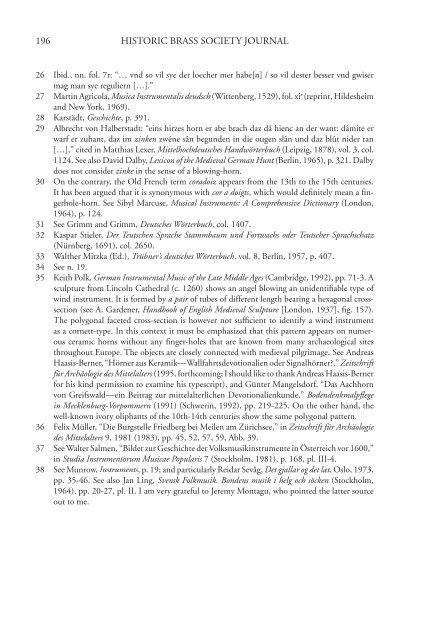A Medieval Wind Instrument From Schlettwein, Thuringia
A Medieval Wind Instrument From Schlettwein, Thuringia
A Medieval Wind Instrument From Schlettwein, Thuringia
You also want an ePaper? Increase the reach of your titles
YUMPU automatically turns print PDFs into web optimized ePapers that Google loves.
196<br />
HISTORIC BRASS SOCIETY JOURNAL<br />
26 Ibid., nn. fol. 7r: “… vnd so vil sye der loecher mer habe[n] / so vil dester besser vnd gwiser<br />
mag man sye reguliern […].”<br />
r<br />
27 Martin Agricola, Musica <strong>Instrument</strong>alis deudsch<br />
(Wittenberg, 1529), fol. xi (reprint, Hildesheim<br />
and New York, 1969).<br />
28 Karstädt, Geschichte, p. 391.<br />
29 Albrecht von Halberstadt: “eins hirzes horn er abe brach daz dâ hienc an der want: dâmite er<br />
warf er zuhant, daz im zinken zwêne sân begunden in die ougen slân und daz blût nider ran<br />
[…],” cited in Matthias Lexer, Mittelhochdeutsches Handwörterbuch (Leipzig, 1878), vol. 3, col.<br />
1124. See also David Dalby, Lexicon of the <strong>Medieval</strong> German Hunt (Berlin, 1965), p. 321. Dalby<br />
does not consider zinke<br />
in the sense of a blowing-horn.<br />
30 On the contrary, the Old French term coradoiz<br />
appears from the 13th to the 15th centuries.<br />
It has been argued that it is synonymous with cor a doigts, which would definitely mean a fingerhole-horn.<br />
See Sibyl Marcuse, Musical <strong>Instrument</strong>s: A Comprehensive Dictionary (London,<br />
1964), p. 124.<br />
31 See Grimm and Grimm, Deutsches Wörterbuch, col. 1407.<br />
32 Kaspar Stieler, Der Teutschen Sprache Stammbaum und Fortwachs oder Teutscher Sprachschatz<br />
(Nürnberg, 1691), col. 2650.<br />
33 Walther Mitzka (Ed.), Trübner’s deutsches Wörterbuch, vol. 8, Berlin, 1957, p. 407.<br />
34 See n. 19.<br />
35 Keith Polk, German <strong>Instrument</strong>al Music of the Late Middle Ages<br />
(Cambridge, 1992), pp. 71-3. A<br />
sculpture from Lincoln Cathedral (c. 1260) shows an angel blowing an unidentifiable type of<br />
wind instrument. It is formed by a pair<br />
of tubes of different length bearing a hexagonal cross-<br />
section (see A. Gardener, Handbook of English <strong>Medieval</strong> Sculpture<br />
[London, 1937], fig. 157).<br />
The polygonal faceted cross-section is however not sufficient to identify a wind instrument<br />
as a cornett-type. In this context it must be emphasized that this pattern appears on numerous<br />
ceramic horns without any finger-holes that are known from many archaeological sites<br />
throughout Europe. The objects are closely connected with medieval pilgrimage. See Andreas<br />
Haasis-Berner, “Hörner aus Keramik—Wallfahrtsdevotionalien oder Signalhörner?,” Zeitschrift<br />
für Archäologie des Mittelalters<br />
(1995, forthcoming; I should like to thank Andreas Haasis-Berner<br />
for his kind permission to examine his typescript), and Günter Mangelsdorf, “Das Aachhorn<br />
von Greifswald—ein Beitrag zur mittelalterlichen Devotionalienkunde,” Bodendenkmalpfl ege<br />
in Mecklenburg-Vorpommern (1991) (Schwerin, 1992), pp. 219-225. On the other hand, the<br />
well-known ivory oliphants of the 10th-14th centuries show the same polygonal pattern.<br />
36 Felix Müller, “Die Burgstelle Friedberg bei Meilen am Zürichsee,” in Zeitschrift für Archäologie<br />
des Mittelalters 9, 1981 (1983), pp. 45, 52, 57, 59, Abb. 39.<br />
37 See Walter Salmen, “Bilder zur Geschichte der Volksmusikinstrumente in Österreich vor 1600,”<br />
in Studia <strong>Instrument</strong>orum Musicae Popularis 7 (Stockholm, 1981), p. 168, pl. III-4.<br />
38 See Munrow, <strong>Instrument</strong>s, p. 19; and particularly Reidar Sevåg, Det gjallar og det læt, Oslo, 1973,<br />
pp. 35-46. See also Jan Ling, Svensk Folkmusik. Bondens musik i helg och söcken (Stockholm,<br />
1964), pp. 20-27, pl. II. I am very grateful to Jeremy Montagu, who pointed the latter source<br />
out to me.
















